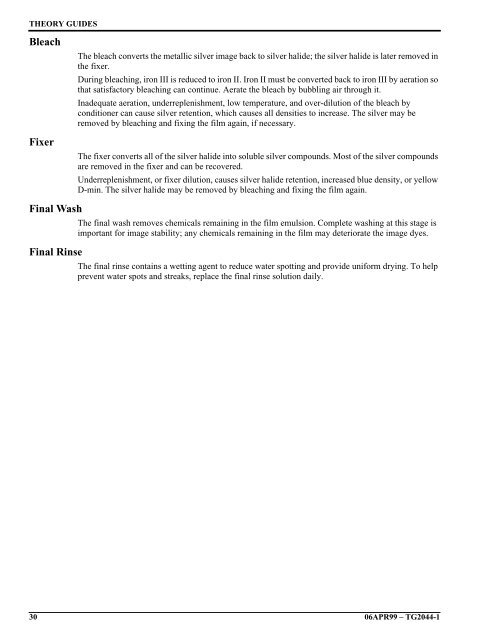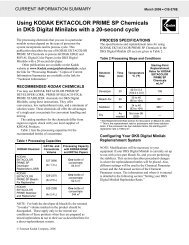Downloaded - Kodak
Downloaded - Kodak
Downloaded - Kodak
You also want an ePaper? Increase the reach of your titles
YUMPU automatically turns print PDFs into web optimized ePapers that Google loves.
THEORY GUIDES<br />
Bleach<br />
Fixer<br />
Final Wash<br />
Final Rinse<br />
The bleach converts the metallic silver image back to silver halide; the silver halide is later removed in<br />
the fixer.<br />
During bleaching, iron III is reduced to iron II. Iron II must be converted back to iron III by aeration so<br />
that satisfactory bleaching can continue. Aerate the bleach by bubbling air through it.<br />
Inadequate aeration, underreplenishment, low temperature, and over-dilution of the bleach by<br />
conditioner can cause silver retention, which causes all densities to increase. The silver may be<br />
removed by bleaching and fixing the film again, if necessary.<br />
The fixer converts all of the silver halide into soluble silver compounds. Most of the silver compounds<br />
are removed in the fixer and can be recovered.<br />
Underreplenishment, or fixer dilution, causes silver halide retention, increased blue density, or yellow<br />
D-min. The silver halide may be removed by bleaching and fixing the film again.<br />
The final wash removes chemicals remaining in the film emulsion. Complete washing at this stage is<br />
important for image stability; any chemicals remaining in the film may deteriorate the image dyes.<br />
The final rinse contains a wetting agent to reduce water spotting and provide uniform drying. To help<br />
prevent water spots and streaks, replace the final rinse solution daily.<br />
30 06APR99 – TG2044-1
















